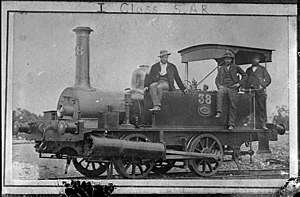South Australian Railways I class (first)
The South Australian Railways I Class Locomotive was originally built by Neilson and Company, Scotland for the Canterbury Provincial Railways, New Zealand in 1873 and numbered 9. In May 1878 the South Australian Railways purchased this locomotive and it was loaded on the ship "Hyderabad", but was wrecked off New Zealand prior to delivery. The locomotive was salvaged and sent to Port Adelaide, it eventually entered service on the SAR on the 15th of April 1879. Between the years 1880-1881 it was renumbered 48 and between the years 1887-1888 it was classed as "I". In October 1905 it was withdrawn from service with the SAR but in May 1906 it was sold to the South Australian Harbour Board and was used in the construction of the Outer Harbour Breakwater. This locomotive was then condemned in August 1909 and eventually scrapped.[1]
| South Australian Railways I Class (1st) | |||||||||||||||||||||||||||||||||
|---|---|---|---|---|---|---|---|---|---|---|---|---|---|---|---|---|---|---|---|---|---|---|---|---|---|---|---|---|---|---|---|---|---|
 South Australian Railways I Class No. 38 | |||||||||||||||||||||||||||||||||
| |||||||||||||||||||||||||||||||||
| |||||||||||||||||||||||||||||||||
| |||||||||||||||||||||||||||||||||
| |||||||||||||||||||||||||||||||||
History
This locomotive was originally built in 1873 for the Canterbury Provincial Railways of New Zealand to work on their 5'3" Broad Gauge railway line Chirstchurch to Lyttleton. It was given the road number 9 on this New Zealand system. With the ultimate decision of the New Zealand Government to convert the 5'3" Broad Gauge line to 3'6" Narrow Gauge, No. 9 along with the rest of the rollingstock were purchased by the South Australian Railways on May 1878. The other locomotives from the Canterbury Provincial Railway were also a part of the SAR and were put into the E and M classes. No. 9 along with the other engines which were destined for South Australia were loaded onto the ship "Hyderabad" for the long journey to Port Adelaide. Unfortunately the ship was wrecked off New Zealand. No. 9 and the other locomotives were eventually salvaged made their way to Port Adelaide. In 1879 No. 9 finally entered the SAR and was in service with its new road number, No. 38. No. 38 didn't get its I class classification until 1887-1888 when it was nominated to be the I class. In 1880-1881 it got renumbered to No. 48. I class locomotive No. 48 was exclusively a shunting locomotive and it was set to work at Morgan. I class No. 48 shunted the station yard and wharf at Morgan for many years, it was possibly used at other locations in its lifetime until it was entrusted to the South Australian Harbours Board in May 1906. The South Australian Harbours Board used this locomotive to assist with the construction work of the Outer Harbour breakwater, until it was condemned in August 1909 and eventually scrapped.[2]
References
- Drymalik, Chris. "Broad Gauge I-class 0-4-0 tank locomotive". Chris's Commonwealth Railways Information (ComRails). Retrieved 31 July 2019.
- FLUCK, R. E.; SAMPSON, R.; BIRD, K. J. (1986). STEAM LOCOMOTIVES AND RAILCARS OF THE SOUTH AUSTRALIAN RAILWAYS. South Australia: Mile End Railway Museum (S.A.) Inc. p. 56. ISBN 0959 5073 37.